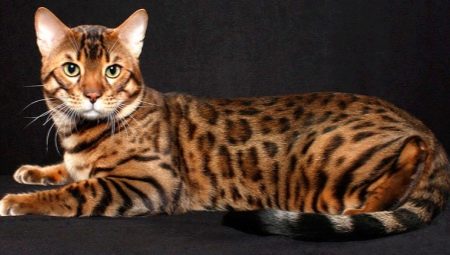Before acquiring a thoroughbred pet, it is advisable to study all the nuances that you will encounter. Bengal cats - a young and relatively little-known, but rapidly gaining popularity breed. Therefore, it is worth considering the main features of Bengal cats and find out what character the representatives of this breed differ in.
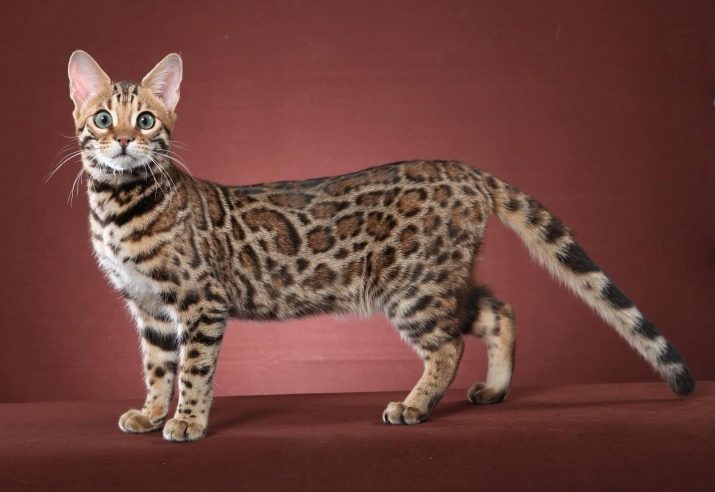
Breed description
The "mother" of this unique breed is the American geneticist Jig Sagden, who, during a trip to South Asia in 1961, acquired a wild Bengal cat and took her home. Only in 1982 she managed to get stable hybrids of a wild Asian cat with a domestic one.
Well, the official year of birth of Bengals is considered to be 1991, when the international standard for cats of this breed was approved, combining the color and swiftness of wild leopards with the complaisance of ordinary domestic cats. According to this standard, an adult (over 2 years old) Bengal cat has the following features:
- the body weight of these animals is usually from 5 to 6 kg;
- the height of the bengals at the withers varies between 25 and 32 cm;
- the life expectancy of such a pet will be from 12 to 15 years;
- the body of these animals must be muscular and stretched;
- the length of the hind legs of the bengals should be longer than that of the front;
- the neck should be long and thick;
- the head has small dimensions relative to the body, wedge-shaped and differs in rounded contours;
- eyes should be saturated green or golden (blue is allowed at colorpoints) and have an oval shape;
- the nose of these cats is quite wide;
- the ears should be at the edges of the head and have a relatively short length, be extended to the base, and also have rounded tips;
- the cheeks of this breed are relatively puffy, and the collections are quite massive.
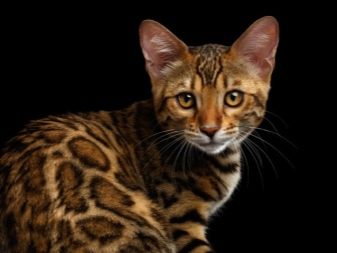
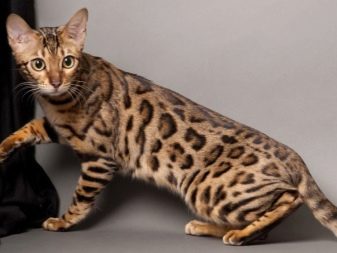
One of the important signs is the color, in which different shades of brown usually serve as the main tone. Bengals are also found, in the color of which snow, blue, coal and even silver tones dominate. Regardless of the base color, all bengals must have a picture, which can be:
- marble;
- spotted (a la leopard);
- rosette (spots with a darker border).
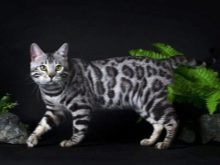
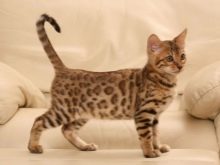
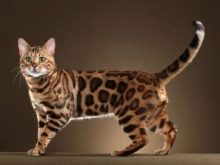
The color of the picture is usually black, gray or brown, while the picture is always darker than the main tone. Any white spots on the wool are considered a defect, such kittens from professional breeders are subject to rejection. The color of the tail can be spotty or ringed, and the tip of the tail must be dark. Regardless of the color option, all cats of this breed are distinguished by the presence of thick, soft and shiny coat.
The length of the coat varies between short and medium. Finally, the voice of bengals differs from most classical breeds - it is noticeably louder, it has much more sound shades.
Nature and behavior
Despite the fact that among the ancestors of this breed there are a lot of really wild cats that it would be simply impossible to keep at home, a purebred bengal is distinguished by a gentle and playful character, as well as a very developed intellect. Moreover, while in other breeds only kittens are more active and playful, bengals retain this character trait throughout their lives. Thanks to this, such cats get along very well with children and other animals.
Such habits require that the pet is always provided with toys and the attention of the owners. In such conditions, bengals “blossom” and even begin to become a bit like dogs in behavior - they can come running to the owner’s call and bring him their toys.
The love of activity and games also has a downside - a bengal growing in an aviary will grow shy and may even show unmotivated aggression. And if it seems to your pet that you are paying little attention to it, he may specially begin to steal small objects. Finally, in the absence of cat toys, the subject of games of the Bengal can be the things needed in the household.
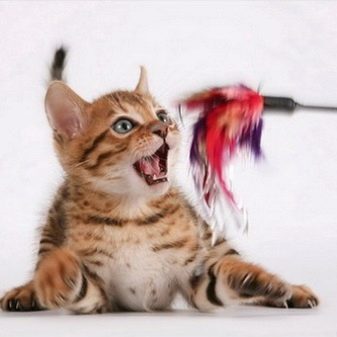
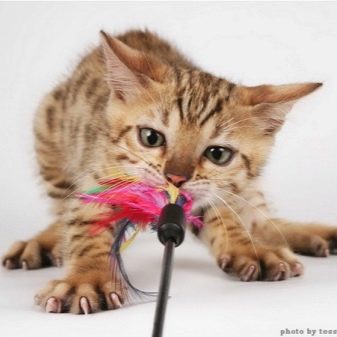
These cats are completely loyal to the owner and gladly accept other members of his family, other cats, dogs and even guests. Of course, you should not immediately stroke the Bengali, having come to visit his owners, but after a few minutes of acquaintance, he will gladly play with you. Please note that the playfulness of all cats is a continuation of hunting instincts, so Bengalis are equally actively "playing" with ordinary toys, and with live mice, birds and other small animals.
But the end of such games is usually the death of a “living toy”, so cages with parrots and domestic rodents in the house where the Bengal cat lives should always be closed. An interesting feature of the nature of these pets can be called atypical for feline love of water. Bengals love to play with water running from an open tap, and some representatives of the breed can even happily take a bath.
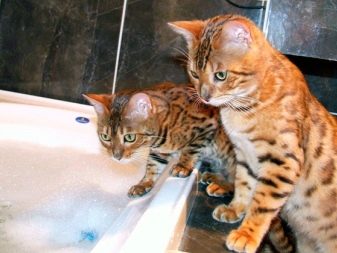
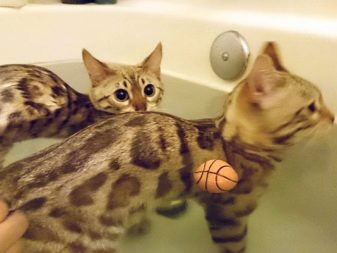
Advantages and disadvantages
The main, from the point of view of breeders, the advantages of cats of this breed over others:
- “Leopard” color, expressive eyes, sharp contours of the body (in the exterior of bengals everything speaks of their wild blood), therefore this breed is ideal for lovers of exotic and simply beautiful cats;
- due to sociability, this breed is a good choice for families where there is already a child or other pets;
- despite their origin, they differ in general by a complaisant character and a developed mind, which makes it possible to even train such cats a little;
- the nature of these cats is characterized by devotion, playfulness and a love of communication;
- like all hybrids, they have pretty good health and rarely get sick;
- most of these cats have short hair, making it easy to care for;
- Bengal wool is almost hypoallergenic;
- these pets are very clean and love water;
- Bengals can be walked on the street.
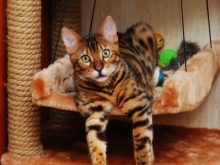
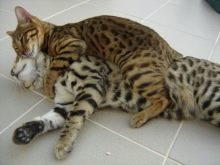

This breed has a number of disadvantages:
- Bengal ancestors led a very active lifestyle, so their health suffers without regular physical activity (you may even need to purchase “simulators”);
- if the cat does not receive enough attention in response to devotion and playfulness, aggression may wake up in it;
- love of water, combined with a lively inquiring mind, can result in the pet learning to open taps and flush the toilet on its own, which can create a number of inconveniences for the owners;
- walking bengals without a leash is impossible - wild blood can make an animal run away at any moment;
- these cats do not like to sit in the owner’s hands for a long time - the love of freedom and activity takes precedence over devotion;
- uncastrated males have a habit of tagging furniture;
- the loud and rich voice of this breed can wake anyone.
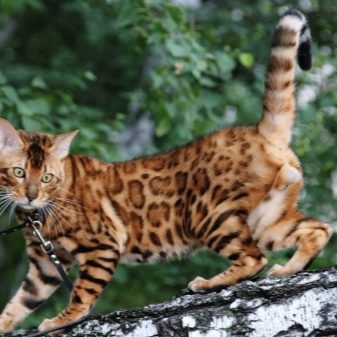
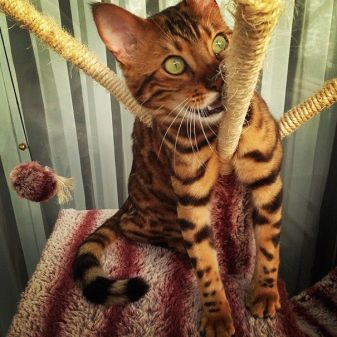
Owner reviews
Most owners of these cats are very pleased with their appearance and character. Also, many owners are pleased that this breed almost does not fade and does not leave wool throughout the apartment. Excessive playfulness sometimes causes the most complaints. With a lack of attention, it develops into shkodliness. Also, not all cat lovers are ready to endure the loud voice of cats of this breed in the spring or when they want to eat.
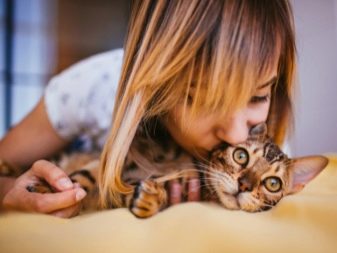

About the features of the breed, see below.
